The Ultimate Guide to Thicknessers with Dust Extraction
When it pertains to woodworking, attaining the ideal surface needs both ability and the right tools. Among the most essential makers for any serious woodworker is the thicknesser, likewise called a planer. Nevertheless, thicknessers can produce considerable quantities of wood shavings and dust, which can make the workshop environment unpleasant and even harmful. This is where thicknessers with integrated dust extraction systems come into play. In this guide, we will dive deep into the world of thicknessers with dust extraction, covering their functions, advantages, and what to search for when buying one.
What is a Thicknesser?
A thicknesser is a woodworking machine designed to smooth and measurement lumber to a particular thickness. It accomplishes this by feeding the wood through a set of turning blades that get rid of product from the surface. Thicknessers come in various sizes and capabilities, however what sets dust extraction-equipped designs apart is their ability to decrease mess and improve air quality in the workshop.
Benefits of Using a Thicknesser with Dust Extraction
- Improved Air Quality: A built-in dust extraction system substantially decreases air-borne particles, which can be harmful to health.
- Cleaner Workspace: Without shavings and dust covering the floor and tools, the workshop stays orderly and more enjoyable to work in.
- Improved Machine Performance: A cleaner machine often runs better, as the build-up of dust and particles can affect the efficiency and longevity of the thicknesser.
- User Comfort: Reducing dust direct exposure adds to a more comfy workplace, enabling woodworkers to focus on their craft.
- Efficiency: Automated dust extraction often operates in tandem with the thicknessing process, saving time on clean-ups and making sure a stable workflow.
Secret Features to Look For in a Thicknesser with Dust Extraction
When looking for a thicknesser with dust extraction, there are numerous essential functions to think about. Comprehending these can assist you select the very best machine for your woodworking needs.
| Function | Description | Significance |
|---|---|---|
| Dust Collection Capacity | The size of the dust bag or bin that gathers shavings. | A bigger capacity indicates less interruptions for clearing. |
| Extraction Efficiency | The effectiveness of the dust extraction system in collecting dust and shavings. | High performance maintains clean air quality and a neat work area. |
| Motor Power | The power of the motor, often measured in horse power (HP). | Higher power permits smoother operation and can deal with denser woods. |
| Feed Rate | The speed at which wood passes through the thicknesser. | Faster feed rates can lead to quicker project conclusion but may affect surface quality. |
| Product and Build Quality | The kinds of materials used in building (e.g., cast iron, aluminum). | Heavy-duty building and construction ensures durability and stability throughout operation. |
Leading Thicknessers with Dust Extraction on the marketplace
Picking the right thicknesser can be daunting with many alternatives readily available. Below are some highly-rated models that supply outstanding dust extraction capabilities:
| Model Name | Motor Power (HP) | Dust Collection Capacity | Price (Approximate) |
|---|---|---|---|
| DeWalt DW734 | 15 | 2.5 Bushels | ₤ 500 |
| Makita 2012NB | 15 | 3 Bushels | ₤ 600 |
| Jet JWP-208HH | 3 HP | 4 Bags (each 2.5 Bushels) | ₤ 1,100 |
| Powermatic PM-15 | 2 HP | 7 Bushels | ₤ 2,200 |
| Bauker Thicknesser | 1.5 HP | 10 Liters | ₤ 300 |
How to Set Up a Thicknesser with Dust Extraction
Setting up a thicknesser with a dust extraction system includes a number of actions to guarantee optimal performance and safety:
- Placement: Position the thicknesser in a well-ventilated location, ideally near a dust extraction system or input ducting.
- Connect Dust Extraction: Ensure the hose is properly connected to both the dust port on the thicknesser and the collection system.
- Plug in and Test: Before turning on the thicknesser, inspect all electrical connections and make sure that no tools or debris are obstructing its operation.
- Change Settings: Configure the thickness settings according to the wanted material thickness.
- Security Gear: Always wear personal protective equipment (PPE) such as safety goggles, dust masks, and hearing protection.
Often Asked Questions (FAQ)
1. Do I need a thicknesser with dust extraction?
While you can utilize a thicknesser without dust extraction, buying one considerably helps to keep the office tidy and ensures much better air quality.
2. How typically should I clear the dust collection bag?
This depends on your thicknesser's usage. Normally, it's a good idea to empty the dust bag after a substantial session of work, or when you observe minimized suction.
3. Can I utilize a thicknesser on wood?
Yes, thicknessers can be used on hardwood. Just ensure that the design you pick has sufficient motor power to manage more difficult products.
4. Elektrohobel Test ?
Dust extraction systems can produce noise, however features such as sound reduction and much better building and construction can lessen sound levels.
5. How do I preserve my thicknesser and dust extraction system?
Routine upkeep consists of cleaning the dust bag, looking for blockages in the tube, and inspecting the blades for sharpness and wear.
A thicknesser with a dust extraction system is an important possession for anybody serious about woodworking. Not just does it boost the quality of your work by offering a tidy, smooth finish, however it also contributes significantly to a more secure and more organized work space. As you aim to update or purchase your very first thicknesser, think about the vital functions, advantages, and designs highlighted in this guide to pick the best tool for your requirements. Your woodworking tasks will thank you!

